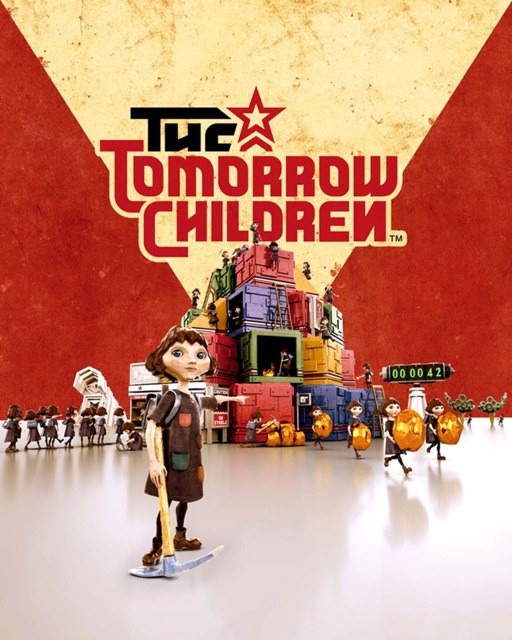Janky Games' Rear View Review of The Tomorrow Children
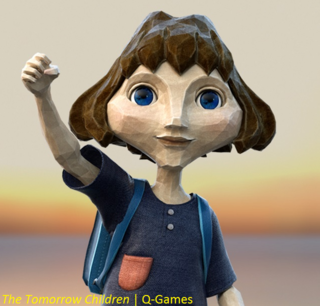
Games are inherently a means of entertainment, so what does it mean when a game is, by design, not entertaining? This is the question that has been gnawing at me since I finished my time with The Tomorrow Children.
The Tomorrow Children is, at its core, a multi-player survival game, requiring people to go out into The Void, an empty abyss in which the entirety of the world resides, and bring back mined rocks and crystals, felled lumber, and hidden Matryoshka dolls in order to power and build their city while simultaneously using the dolls to increase the city’s population with living figurines. Once the player’s inventory is filled, it’s back to the city to use the collected harvest to craft items for survival and further the power of the people. However, all of the character, all of the nuance, all of the parts that make Children worth mentioning is outside of the game’s core.
The Tomorrow Children is communism incarnate. Each and every part of Children has been crafted to serve the Marxist overtones of the game, excising from itself all means of enjoyment. However, the methods the developers have taken in crafting a Marxist nightmare, and the lengths to which they have gone, makes The Tomorrow Children truly brilliant.
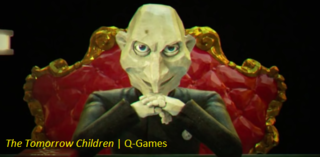
Visually, The Tomorrow Children is one of the most striking games on the PS4. It is not a powerhouse in the sense that it will inspire awe with its majestic landscapes and visually impressive crowds, but quite the opposite as the oppressive, yet fantastically whimsical style of the city, the stark bleakness of The Void, the minimalist design of roaming kaiju all work together to build a world that is wholly unique, eerie, and beautiful in equal measure. The characters all share an aesthetic of crudely carved wooden puppets, making the painted on joyful faces of the city’s populous altogether more macabre when juxtaposed with their dour demeanor. Every time you look into the faces of the sharply gaunt guards, the fierce eyes of joyless merchants, or the seemingly endless gray of The Void, dread percolates up from the pit of your stomach as it slowly reminds you that you are in this fantasy nightmare willingly.
Beyond the visual design, the interactions in the world all build up the communist motif. From Russian being the only language in the game, spoken out during one-sided dialogue with NPCs and instructions given to the player over the radio, to propaganda playing on television sets and over the city’s broadcast speakers, Children feels like a world where The Cold War never came to cessation. There is the ever present reminder of work needing to be done as lights will flicker due to a lack of power and people will bemoan the lack of food and dwindling rations, all feeding back into the systems of running on a treadmill to charge the city’s batteries as a television plays pro-communist propaganda in front of your character, or shaking down trees to gather apples to feed the people. Children’s game play is laborious, and for that it is apt that the more one plays, the more toil points one will achieve, an in-game equivalence of experience points, allowing for a light RPG mechanic of leveling up and increasing character stats to increase the efficiency of one’s work.
Playing Children isn’t an enjoyable act. What constitutes as game play, the loop of harvesting and crafting, has been seen time and again throughout the early access market, but the systems built into Children have been designed to seemingly inhibit enjoyment. While games like Minecraft and Terraria allow for vast worlds to be explored and interesting upgrades for the player to be created, Children has decided that small absurdist areas are best, and the majority of upgrades go to the city as opposed to the player’s character. Nothing is ever for the benefit of one’s self in Children; even the few upgrades and perks that can be obtained for the character only exist so that the player can be of more use to society as a whole.
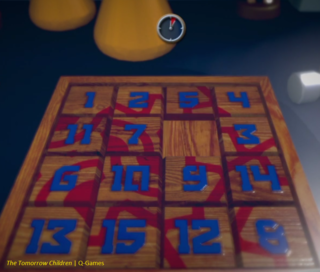
The crux of the problems I have with The Tomorrow Children can be understood in my story of building a hover car to traverse The Void. After being told by a guard, there for my own safety of course, to not loaf about, I proceeded to engage with the city’s workbench. Another player, however, was already at work on it, so I was instead forced to stand and wait in a queue until she finished her own work.Once the other player had finished and made off with their sapling to plant and bring more food to the city. I walked up to the workbench and selected my hover car, expecting a simple timer to pass until the item would be completed. What greeted me, however, was a sixteen tile sliding block puzzle and a timer. While I admit it is innovative to include this puzzle into the crafting system of a video game, that is same sort of innovation as adding spikes to the interior of a coffin to create an iron maiden. After struggling with the puzzle I managed to complete it just shy of running out of time. For my efforts, I was rewarded with a hover car of my very own as it meandered it’s way down the conveyor belt and onto the ground. It was when I attempted to get into the car and drive that I was, yet again, reminded that this game was communism incarnate.
You see, I wasn’t allowed to drive my car because I didn’t have the correct license, and I couldn’t obtain the license until I had enough toil points built up from daily labor to buy my bourgeoisie papers. All this time, I had forgotten my place in society, for I was simply a member of the proletariat, which meant that I was not a full citizen of the cities of The Tomorrow Children. I could not vote in elections, I could not operate a vehicle on my own, and I should stop loafing about and get back to work. All of this dawned on me as I sat on my couch, completely defeated, as another member of the city casually got into my car and drove off, only to crash into the side of a building. Or rather I should call it society’s car, for nothing is truly your own in The Tomorrow Children.
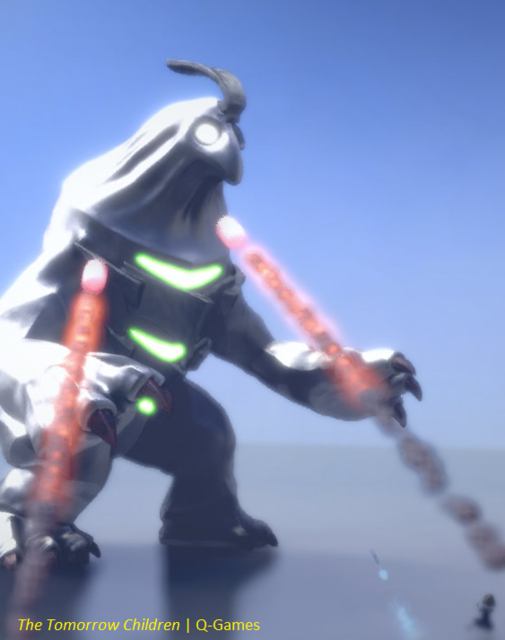
All the time spent in The Tomorrow Children is filled with doldrum tasks to improve the standard of living for yourself, other players, and the brought-to-life Matryoshka dolls that fill out the population of the city. On the rare occasion, monsters will come out of The Void and attack the city. Ranging from child-sized bloated insects with gas masks for faces and foot-long syringes for their proboscises, to lumbering kaiju hundreds of feet tall, the monsters invade the shanty town that you have called home, leaving you to defend it with mounted turrets and shotguns. After enough time passes, the monsters leave, whether due to defeat or pity remains unclear. What does remain, however, is the realization that the excitement of action was entirely ephemeral, and now the town is low on food, so trees need to get shaken and apples harvested yet again.
While offered for free, Children is lousy with micro-transactions. Every merchant in the game, and even guards when first spoken to, will monologue about how the toil and despair can be made easier if the player were to only slip them a few bucks. A black market brochure offers better shovels, pick axes and outfits for a few Freeman dollars, the in-game currency that can be purchased through the PlayStation store. The much lauded bourgeoisie papers could be yours if right now if you only slipped that long, carved-nosed guard a few Freemans. That shotgun? Those licenses? The haute bourgeoisie isn’t out of reach if you’re willing to pay, and who wouldn’t want to when the only other option is to be a low, slovenly member of the proletariat, toiling away for the progress of society?
The Tomorrow Children is simultaneously a wonderful exploration into Marxist society and a horrific game to play. For every moment that I spent falling in love with the world, the miasmic waste of The Void, the stark idolatry of communism, the sheer aesthetic wonder, I was equally left thinking that I hated every moment being there. It is why I am left with the question of what it means when a game is purposefully designed to go against its inherent nature of being entertainment. The answer, as to put it simply, is that I am left with art.
The art that is The Tomorrow Children is brilliant; the developers at Q-Games have created an interactive, digital puppetry of communism in a surrealist world. From waiting in line to use shared workbenches that are powered off of shared resources used to produce shared items, which can only be used after enough time and toil has been exerted (unless enough money is paid to the right people), to endless streams of propagandist posters, videos, and radio broadcasts, The Tomorrow Children is everything that I presume Q-Games wanted it to be. It just so happens that none of it is fun to engage with on any level. I love The Tomorrow Children; I want it to exist forever so that people can see it, interact with it, and judge it for themselves. I just also never want to play it ever again.
